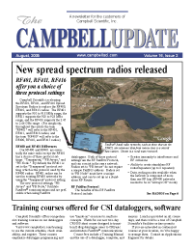RF401, RF411, RF416 offer you a choice of three protocol settings
Campbell Scientific is releasing the RF401, RF411, and RF416 Spread-Spectrum Radios to replace the RF400, RF410, and RF415 radios. The RF401 supports the 910 to 918 MHz range, the RF411 supports the 920 to 928 MHz range, and the RF416 supports the 2.45 to 2.46 GHz range. (For simplicity, throughout this article the term "RF401" will refer to the RF401, RF411, and RF416 radios, and the term "RF400" will refer to the RF400, RF410, and RF415 radios.)
RF400 and RF401 Differences
Our RF400 and RF401 are essentially the same radio except the RF401 has a choice of three protocol settings: "Transparent," "PB Aware," and "PB Node." By default, the RF401 is set to the "Transparent" protocol setting, which is the protocol used by the RF400 radios. RF401 radios can be used in existing RF400 networks by using the "Transparent" protocol setting.
The new protocol settings, "PB Aware" and "PB Node," facilitate PAKBUS® communications and are preferable when using PAKBUS dataloggers. Both of these protocol settings use the RF PAKBUS Protocol, and can coexist in the same network. Radios set to "PB Aware" do not require a unique PAKBUS address. Radios set to "PB Node" must have a unique address, and can be set up as a stand-alone RF router.
RF PakBus Protocol
The benefits of the RF PAKBUS Protocol include:
- Greater immunity to interference and RF collisions
- Ability to create stand-alone RF router/repeaters (up to 8 repeaters)
- Duty-cycling modes available when the network is composed of more than one RF hop (RF400 networks needed to be in "Always ON" mode)
- Reduced power consumption by the datalogger, as the radios perform "packet address filtering"
- Faster communications due to elimina- tion of some of the small "link state packets"
- Automatic selection of the best RF path when there are parallel RF paths
Retry and Packet Acknowledgment Features
The RF401's packet acknowledgment and retry features provide a high degree of recovery from the inevitable RF packet collisions. Within an RF400 PAKBUS network, retries cannot be enabled because all radios have the same radio address, causing the RF acknowledgments to collide.
Hop Metric and Signal Strength
Our hop metric is based on signal strength, which allows the PAKBUS routing algorithms to automatically take the best route. This optimizes communications when a node has two RF routes—one route that has good signal strength on each of the hops and another route that is direct but has poor signal strength.
RF Routers
Radios with the "PB Node" protocol can be set up as a stand-alone RF Router. In this mode, the radio is not attached to any datalogger or PC; it is ONLY an RF router.
Configuring the RF401
You can configure the RF401 using software such as DevConfig version 1.2 or later, PAKBus Graph, or a user-supplied terminal emulator package such as HyperTerminal. DevConfig is bundled with our PC400 and LoggerNet software, or can be downloaded at no charge from our Web site.
When using either DevConfig or PAKBUS Graph, you can view and edit all of the PAKBUS settings. When using terminal emulation software, the radio's on-board Setup Menu is used to change the settings. The only PAKBUS setting that can be changed is the PAKBUS address.
Associated Equipment
The RF401 radios are compatible with the same antenna and power supply options as the RF400 radios. Antennas can be attached to a tripod or tower using the CM230 Adjustable Inclination Mount, which will accept antennas with 0.75" to 1.0" diameters.
CR206, CR211, and CR216
To reflect the change in the RF protocol, the CR205, CR210, and CR215 dataloggers will be replaced by the CR206, CR211, and CR216, respectively. Because the CR200-series dataloggers have always been PAKBUS devices, the changes are not as extensive as the changes to the spread spectrum radios. The dataloggers have a new setting that enables/disables the RF PAKBUS protocol and allows the datalogger to operate in either an RF400/CR205 or RF401/CR206 network.
Retrofitting the Radios
RF400 customers who use their radios in a PAKBUS network might consider upgrading their radios to RF401s. To upgrade a radio, an RMA is required.

